Okra Is Oh So Global
- Oops!Something went wrong.Please try again later.
Okra has a home in hearts and kitchens around the globe.
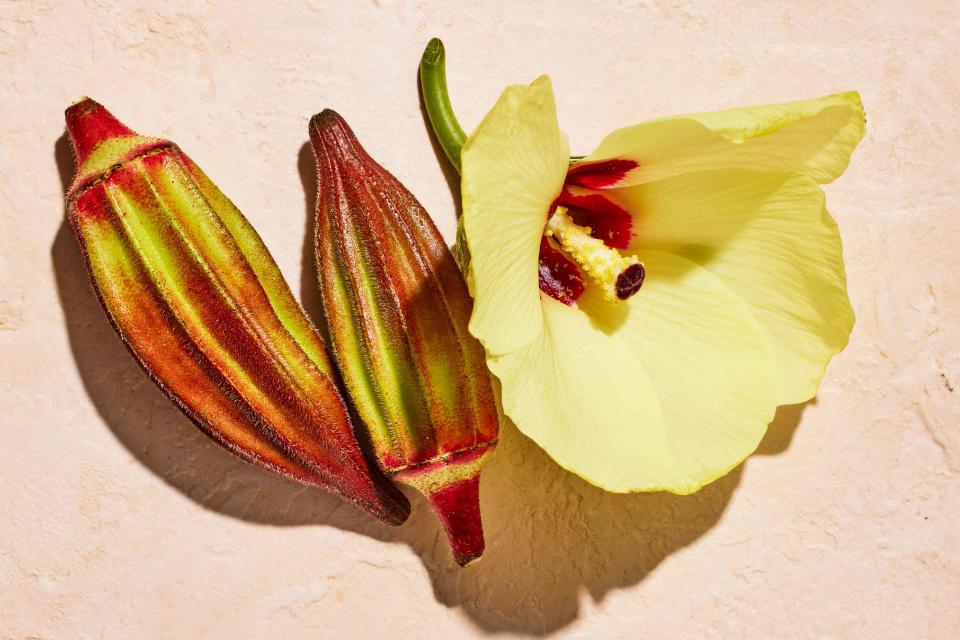
Antonis Achilleos / Food Styling by Emily Nabors Hall / Prop Styling by Lydia Purcell
The world is blessed with a bounty of poetry about okra, and this does not surprise me in the slightest. The verses run the gamut from the ridiculous (musings on its mucilaginous texture and the polarizing nature thereof) to the reverent (reflections on okra as a totem of survival, every last syllable both earnest and earned). Okra doesn’t just happen by accident; you either have to be in a place that embraces it, or you have to will it into your life because you have realized you cannot be your full self without this singular and perfect plant.
“Whenever I see okra popping up, it is a way for me to connect with my ancestors. Really, that’s how deep it is,” Pierre Thiam, chef and author of the upcoming cookbook Simply West African, tells me on a recent phone call. Thiam and I had met a few years back, and when he told me that okra is his favorite food, I showed him the flowering red okra stem I have tattooed on the back of my left arm. It started a conversation I hope will go on for ages. “Okra is spiritual, and that’s why it’s not for everyone,” Thiam says. “Many are called, but few are chosen. I feel that way when I see people who don’t like okra. I feel bad for them. I’m like, ‘Oh, sorry, more for me.’”
"To acknowledge me is to acknowledge the soil. To marvel
at black cardamom, cinnamon, fried okra."
Excerpt from “Lost Jewels” by Megha Rao (2022)
The genetic and geographic trail of okra is as slippery as its insides. This member of the mallow family (which includes hibiscus, marsh mallow, cotton, and hollyhock) was once in the genus Hibiscus before it was reclassified as Abelmoschus in the 18th century. And though okra’s genesis was once widely assumed to be in tropical West Africa, Jessica B. Harris (a food historian and author, and as close to a professional okra-ologist as exists on this earth) related in an essay for 64 Parishes that northeastern Africa’s Upper Nile Valley (modern-day Ethiopia, Sudan, and Eritrea), where okra grows wild and free, is a more likely point of origin — though scholars from Southeast Asia and South Asia surely would like their chance to stir that pot.
Vishwesh Bhatt, an Oxford, Mississippi–based chef born in Gujarat, India, confesses in his 2022 cookbook I Am From Here that for a very long time, he was under the impression that okra was native to India. “I once even tried to argue that with a friend from Senegal. (I lost.) I may be forgiven for being misinformed, given that okra is a staple across India.” If it’s of any consolation to Bhatt, in 2021, India produced 59.7% of the world’s okra, and the late culinary historian Karen Hess once wrote that okra came to India “so early that it is very nearly regarded there as being indigenous.”
"Oh okra’s favored far and wide,
Oh you can eat it boiled or fried,
Oh either slick or crisp inside,
Oh I once knew a man who died
Without okra."
Excerpt from “To Okra” by Roy Blount Jr. (1976)
At some point, okra made its way to Egypt, where its presence as a cultivated crop was documented in 1216 by Spanish-born botanist, pharmacist, and theologian Ahmad bin Muhammad bin Mufarrij bin Abdillah. His protégé Ibn al-Baytar went on to quote an unnamed source as saying it had few nutritive properties, produced blood that is “bad,” and agreed only with people of a “hot temperament,” though this harm could be averted with “a lot of hot spices.” (Let the record show that okra does nothing of the kind. In fact, in recent years, okra has been cited by the National Library of Medicine as having the potential to help people with diabetes and digestive issues.) There’s a reason Harris refers to okra as “the Rodney Dangerfield of vegetables” — the lack of respect is a centuries-old historical fact, perhaps as much a referendum on okra eaters as it is on the foodstuff itself.
"Your stringy, slippery texture
reminds them of the creature
from the movie Aliens.
But I tell my friends if they don’t like you
they are cheating themselves;
you were brought from Africa
as seeds, hidden in the ears and hair
of slaves."
Excerpt from “In Praise of Okra” by January Gill O’Neil (2009)
Ships bearing human beings who were stolen from their homes also almost certainly brought okra seeds across the Atlantic along with them. Accounts vary as to the method; farmer and author Leah Penniman dedicates her book Farming While Black to “our ancestral grandmothers, who braided seeds in their hair before being forced to board transatlantic slave ships, believing against the odds in a future of sovereignty on land.”
Enslaved Black women’s labor and knowledge made a seismic impact on the cuisine of the cultures they’d been subjugated to serve. The next major historical documentation of okra showed it growing in Brazil alongside other African crops like sesame and spider plants. This wasn’t by chance; traffickers were concerned solely with keeping their captives (over 5 million of them) fueled by inexpensive foods that they would eat.
Okra was familiar to them, and it grew well in the climate, so it went into the ground and the rations—and into the sustenance and spirituality of the nation where it had been transplanted. Each June 24 and 29, Black Brazilian practitioners of Candomblé, a religion of the African diaspora, make okra-based amalá de Xangô to celebrate the god of justice, fire, and equilibrium, placing 12 whole pods around the perimeter of the dish to evoke a crown. Okra may be sacred, but it is not precious, and to this day, it’s a staple in everyday Brazilian dishes like caruru and frango com quiabo.
"Still
you weep when stirred,
make a gumbo worth
fasting for. Seventh son,
pilgrim, you once were a slave
I heard, a language
smuggled here in our hair
to teach us home
& what freedom
wasn’t."
Excerpt from “Ode to Okra” by Kevin Young (2011)
It’s safe to assume okra’s path from Brazil and Africa to the rest of the Americas was also laid by the passage of African people. In the 1700s, there are historical mentions of okra being grown in the slave gardens of Thomas Jefferson’s Monticello and being served in Philadelphia’s pepper pot — a close kin to West African and Caribbean stews. Cookbooks in the 1880s attributed okra-centric recipes to white women deemed homekeeping experts. Who do we think taught them its pleasures?
From 1936 to 1938, the Works Progress Administration tasked workers to interview formerly enslaved people throughout the South and Appalachia, and time and time again, octogenarians like Prince Bee, Lou Smith, and Lizzie Farmer invoked “coffee” made of parched okra seeds, and meals of okra served with meager meat like hog jowl and possum, made palatable, even pleasurable, by hands used to making the most from what little they were given. Gumbo — a word that is derived from ki ngombo, the word for okra in several West African languages — lies cheek-by-jowl with the identity of Louisiana, and South Carolina’s Lowcountry would be so lessened by the absence of okra-packed pilau. For so many souls, okra stands for endurance. For survival. For joy in the face of long and terrible odds.
"Early morning. Still dark. I am in a taxi. The most elegant ‘ti Creole in the world is on the radio. I catch a sliver and think how one tiny word can be sacred — an artifact — the only green thing that returns inside the beak.
okra"
Excerpt from “The Ark: Self-Portrait as Aphrodite Using Her Dress for a Sail, ii” by Robin Coste Lewis (2022)
I could practically hear Thiam grinning over the phone as he told me about the food he’d grown up eating. He makes his home in California now with his wife, Lisa, and their three-year-old daughter, Na’ia, whom they are raising to be an okra lover like them. Thiam is from Senegal, and Lisa is from Japan, and “We’re both just crazy for okra. That’s the ingredient that unites us in this family.” He describes a Japanese natto okra dish that all three love, as well as his favorite way to share it — in an okra stew as fundamental to him as mother’s milk, rich with smoked fish and palm oil — and I think we’re both about to gnaw on our phones.
He laments that he’s been unable to successfully grow okra where he’s living, and I tell him how there are okra flowers blooming year-round in an AeroGarden in my Brooklyn hallway because I can’t stand to be without them. I offer to mail him some seeds — my favorite Jing Orange, Red Burgundy, and Bowling Red varieties — so he can grow them with Na’ia, and he says yes. We both just know he’ll find a way to make them sing.
Okra recipes
Bhindi Masala with Tomato Tarka (Stir-Fried Okra with Tomatoes and Spices)
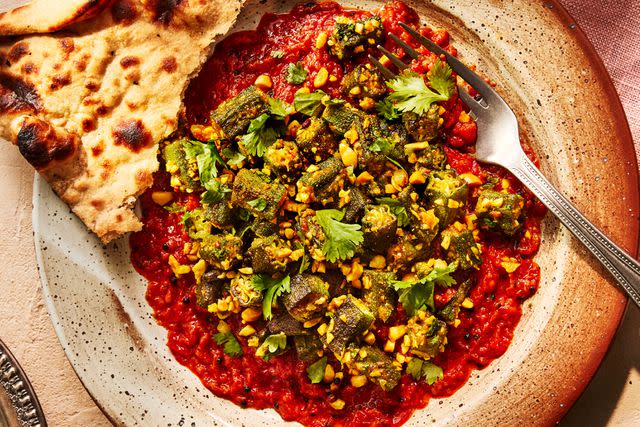
Antonis Achilleos / Food Styling by Emily Nabors Hall / Prop Styling by Lydia Purcell
2020 F&W Best New Chef Niven Patel puts a jammy, spiced-tomato spin on bhindi masala, a popular North Indian okra dish. By frying spices in a bit of oil (a cooking technique called tarka, or tadka), Patel adds distinct floral, earthy, and slightly spicy notes to the simmered tomatoes that pair with the stir-fried okra. Take time to air-dry the okra slices before stir-frying so each piece develops a pleasingly crisp exterior.
Okra with Eggplant and Grilled Prawns
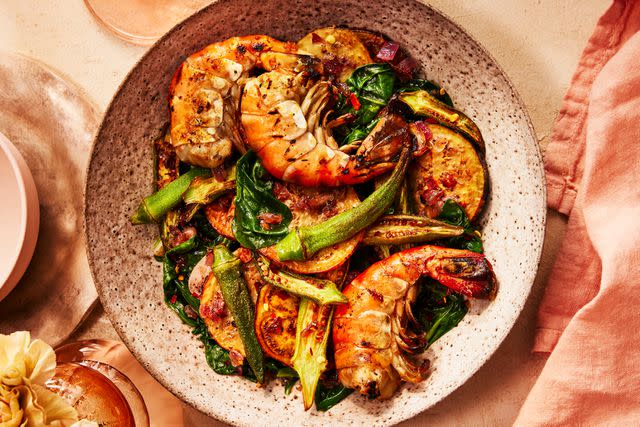
Antonis Achilleos / Food Styling by Emily Nabors Hall / Prop Styling by Lydia Purcell
After a trip to Jamestown in Accra, Ghana, cookbook author Zoe Adjonyoh was inspired to create a dish that features simply sautéed okra and garden eggs — a West and Central African variety of small white eggplant named for its egglike shape. You can substitute any small eggplant, but seek out this variety if you can for its rich, bitter flavor; creamy flesh; and tender skin.
Okura No Nibitashi (Marinated Okra in Flavored Dashi Sauce)
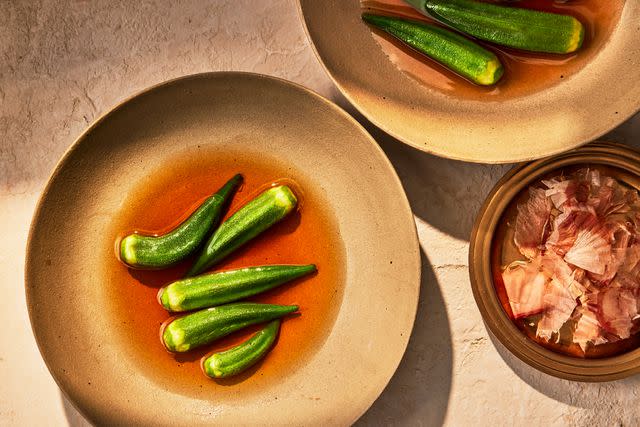
Antonis Achilleos / Food Styling by Emily Nabors Hall / Prop Styling by Lydia Purcell
Crisp whole okra take on the lightly sweet and smoky flavors of Japanese cooking authority Hiroko Shimbo’s dashi and are served cold with the broth. Trim off the tough part near the okra stem and roll the pods in salt to soften the fuzz for a tender and refreshing experience with each bite.
Maryland Summer Succotash with Fish Pepper Vinaigrette
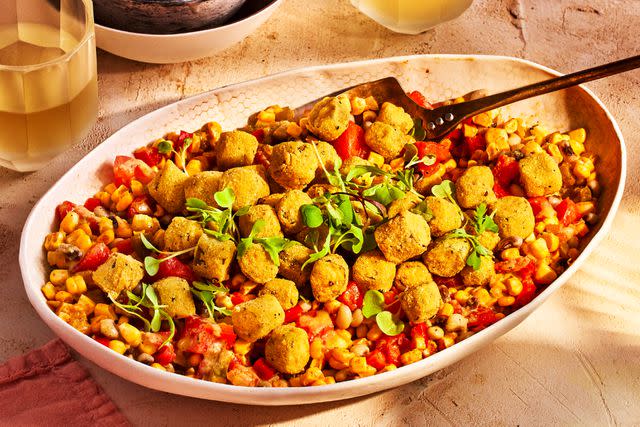
Antonis Achilleos / Food Styling by Emily Nabors Hall / Prop Styling by Lydia Purcell
Baltimore-based chef David Thomas created this seasonal succotash as an ode to his grandmother’s. Thomas’ version, topped with fried pickled okra, puts the colorful bounty of summer produce on full display. The cornmeal-crusted okra bring a light crunch and tang to the dish and add an unexpected twist. Fish pepper, a small, vibrant chile that was once a staple in the Chesapeake Bay, adds a fiery heat to the sweet sautéed vegetables.
Okra Mac and Cheese with Andouille Sausage

Antonis Achilleos / Food Styling by Emily Nabors Hall / Prop Styling by Lydia Purcell
Introduced to New Orleans in the early 1700s, okra was originally referred to as kingombo. This Angolan word was later shortened to gombo, or gumbo, to describe the hearty soup traditionally thickened with okra. New Orleans chef Kevin Belton brings okra’s thickening power and a little Louisiana flair to his mac and cheese, with Creole seasoning, andouille sausage, and a cheddar and Gruyère sauce that’s made extra luscious from the properties of the mucilage found inside okra’s pods.
Crispy Snacking Okra
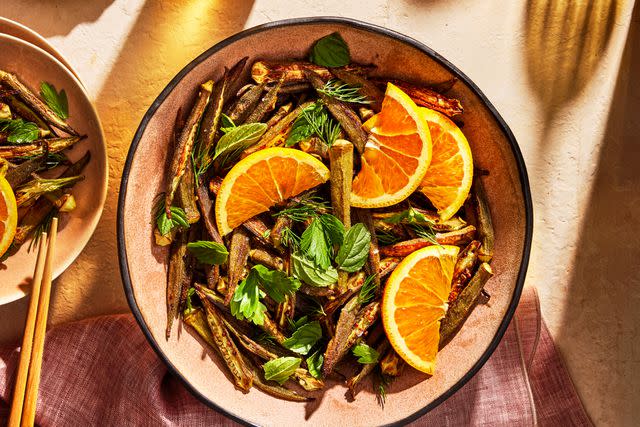
Antonis Achilleos / Food Styling by Emily Nabors Hall / Prop Styling by Lydia Purcell
A hot cast-iron skillet is the key to transforming chef Ari Miller’s tender peak- season okra into a crunchy, chiplike snack. Roasting the okra before searing not only ensures that the pods are tender, but it also helps dry out the surface for better crisping. Finishing with a squeeze of fresh citrus juice, a handful of tender herbs, and a sprinkle of flaky sea salt is all it takes to round out this irresistible treat.
For more Food & Wine news, make sure to sign up for our newsletter!
Read the original article on Food & Wine.

